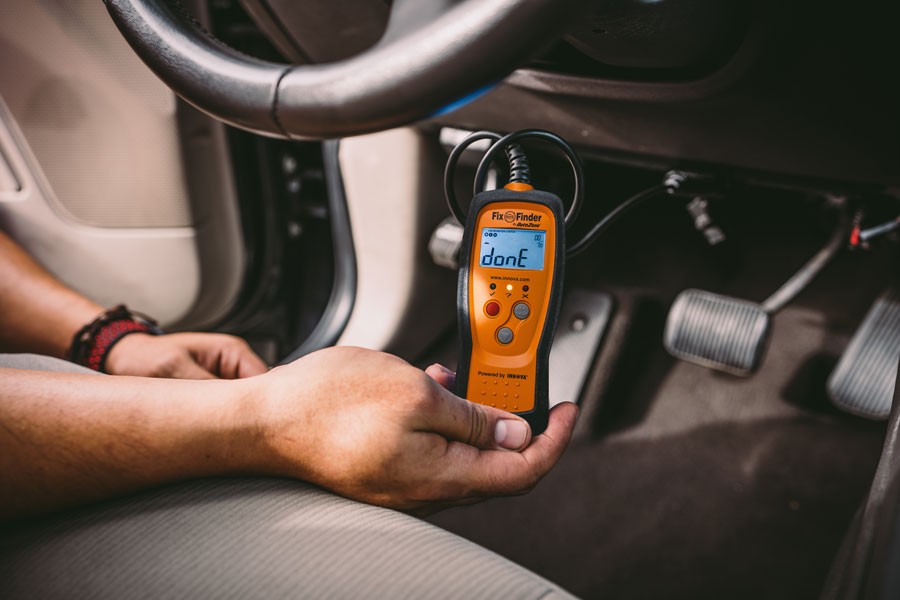Unlocking your car’s hidden health data is easier than you might think. With a car diagnostic tool, also known as an OBD2 scanner, you can quickly understand what’s going on under the hood when that check engine light illuminates or when you experience performance issues. This guide will walk you through the simple steps of how to use a car diagnostic tool, empowering you to troubleshoot problems and potentially save money on auto repairs.
Locating the OBD2 Port in Your Vehicle
The first step is to find your car’s OBD2 port. For almost all cars and light trucks manufactured since 1996, the OBD2 port is standardized for easy access. You’ll typically find this 16-pin connector located beneath the dashboard on the driver’s side.
In some vehicle models, the OBD2 port might be subtly placed within the center console or even under the dashboard on the passenger side. If you’re having trouble locating it, consult your vehicle’s owner’s manual for specific guidance. The port is designed with a trapezoidal shape, ensuring that the OBD2 scanner connector fits in only one orientation.
Connecting Your OBD2 Scanner: A Simple Process
Connecting the OBD2 scanner is straightforward. Just align the trapezoidal connector of your scan tool with the OBD2 port in your car. Gently push the two connectors together firmly. You might feel a slight resistance, and a small wiggle can help ensure a secure connection.
Follow these steps for a smooth connection:
- Turn off the ignition: Make sure your car’s ignition is completely off before you begin.
- Plug in the scan tool: Connect the OBD2 scanner to the diagnostic port you located earlier.
- Turn the ignition to “ON”: Turn the ignition key to the “ON” position. This powers up your car’s electrical system but does not start the engine.
- Power up the scanner: In most cases, the OBD2 port will provide power to your scan tool automatically.
- Wait for boot-up: Allow your OBD2 scanner to complete its start-up sequence.
Once powered on, your scan tool may prompt you for additional vehicle information, such as the engine size, Vehicle Identification Number (VIN), or instructions to start the engine. Follow the on-screen prompts provided by your specific scanner.
Navigating the OBD2 Scanner Menu Options
After your OBD2 scanner boots up successfully, you’ll be presented with a menu. The options available will vary depending on whether you are using a basic code reader or a more advanced professional-grade diagnostic tool. However, common menu options typically include:
- Read Codes: Selecting this option instructs the scanner to retrieve and display any stored or pending Diagnostic Trouble Codes (DTCs). These codes are essentially error messages from your car’s computer, indicating potential issues. Along with the code itself, some scanners may also provide a brief description of the problem. If multiple codes are present, the scanner will usually scroll through them.
- Erase Codes: This function allows you to clear stored DTCs from your car’s computer memory. Typically, the scanner will ask for confirmation before erasing codes to prevent accidental deletion. It’s important to note that erasing codes doesn’t fix the underlying problem, it only clears the record of it. If the issue persists, the check engine light and the code will likely return.
- Live Data: For scanners with this capability, “Live Data” mode allows you to view real-time sensor readings from various parts of your vehicle’s engine and systems. This is invaluable for monitoring sensor performance and identifying anomalies. You can observe parameters like engine temperature, RPM, oxygen sensor readings, and more, helping you pinpoint sensors that are out of range or malfunctioning.
- Freeze Frame: This feature captures a snapshot of sensor data at the exact moment a DTC was triggered. Freeze frame data provides valuable context by showing the conditions under which the fault occurred, which can be helpful for diagnosis.
- Vehicle Info: This section typically displays basic information about your vehicle, such as the VIN and vehicle calibration IDs.
- I/M Readiness: Short for Inspection and Maintenance Readiness, this option checks the status of various emissions-related systems. It indicates whether your vehicle is ready for an emissions or smog test, and can highlight potential issues that might cause you to fail.
Most OBD2 scanners are equipped with buttons for navigation. Arrow buttons help you move through menu options, a select or enter button confirms your choices, and often a back button is included to return to the previous menu screen. Even Bluetooth or Wi-Fi enabled scanners controlled via smartphone apps will usually have intuitive on-screen controls mimicking these button functions.
Understanding Diagnostic Trouble Codes (DTCs)
When you select “Read Codes,” the scanner will display a code, or multiple codes, that need to be interpreted. While some scanners offer a brief on-screen description, understanding the structure of these codes is crucial for effective troubleshooting. DTCs follow a standardized five-character format: a letter followed by four numbers, for example, P0301.
The first letter of the DTC indicates the vehicle system where the fault originated:
- P (Powertrain): Relates to engine, transmission, fuel system, and emissions control systems.
- B (Body): Indicates issues with body-related systems such as airbags, power windows, and interior electronics.
- C (Chassis): Points to problems with chassis systems, including ABS, braking, suspension, and steering.
- U (Network/Communication): Signifies communication issues within the vehicle’s computer network.
The first number following the letter is either a 0 or 1. ‘0’ denotes a generic code, standardized across all vehicle manufacturers. ‘1’ indicates a manufacturer-specific code, meaning the code definition might vary slightly between car brands.
The subsequent digits provide further detail about the specific system and fault. The third digit often categorizes the sub-system:
- 1 & 2: Fuel and air metering related issues.
- 3: Ignition system or misfire faults.
- 4: Auxiliary emission control system problems.
- 5: Vehicle speed control or idle control system faults.
- 7, 8, & 9: Transmission-related codes.
- A, B, & C: Hybrid-specific codes.
The final two digits pinpoint the specific component or circuit experiencing the problem. With hundreds of possible combinations, resources like online DTC code databases or repair manuals are invaluable for detailed code definitions.
Let’s revisit our example code, P0301. Based on the structure:
- P: Powertrain system.
- 0: Generic code.
- 3: Ignition system or misfire.
- 01: Specific to cylinder #1.
Therefore, P0301 indicates a generic powertrain code related to a misfire in cylinder #1.
Similarly, consider the code P0138. This code indicates a Powertrain (P) generic (0) code related to fuel/air metering (1), specifically ‘O2 Sensor Circuit High Voltage Bank 1 Sensor 2’ (38). This points to a high voltage reading from the downstream oxygen sensor on bank 1.
Saving Money with a Car Diagnostic Tool
Owning an OBD2 scanner can lead to significant savings on car repairs in several ways.
Firstly, when your check engine light comes on, or you notice performance issues, a quick scan can provide initial clues about the potential source of the problem. While it might not pinpoint the exact failed part, it narrows down the area of concern, guiding your troubleshooting efforts. This initial information is valuable, even before consulting a professional mechanic.
Secondly, as mentioned earlier, the I/M Readiness test can help you determine if your vehicle is likely to pass an upcoming emissions test. By identifying potential emissions-related faults beforehand, you can address them proactively, avoiding costly re-tests and potential fines.
Furthermore, for those comfortable with DIY car repairs, an OBD2 scanner empowers you to diagnose and potentially fix issues yourself. For instance, if a scan reveals a P0138 code (oxygen sensor high voltage), and you are comfortable replacing an oxygen sensor, you can purchase the replacement part, perform the repair yourself, and then use the scanner to clear the code. This avoids diagnostic fees and potentially reduces labor costs at a repair shop.
Investing in an OBD2 scanner from reputable retailers like AutoZone can expand your DIY capabilities and provide peace of mind. Alternatively, explore AutoZone’s Loan-A-Tool program for no-charge borrowing of diagnostic tools if you only need a scanner for occasional use.
Frequently Asked Questions (FAQ)
How do you use an OBD II scanner?
Simply plug the scanner into your car’s OBD2 port, turn the ignition to the “ON” position (engine off), and follow the on-screen instructions to read codes and access other diagnostic features.
Does the car have to be running to use an OBD2 scanner?
No, in most cases, you can read trouble codes with the ignition in the “ON” position, without the engine running. The OBD2 port provides power to the scanner in this mode.
How do I interpret my OBD scanner readings?
Select “Read Codes” on your scanner to display DTCs. Note down the codes. The first letter indicates the system (P=Powertrain, B=Body, C=Chassis, U=Network). The numbers provide more specific information about the fault. Consult a DTC code database or repair manual for detailed definitions.
Can you plug in an OBD scanner while the car is running?
While technically possible, it’s generally not recommended to plug in or unplug an OBD2 scanner while the engine is running. It’s best practice to turn the ignition off before connecting or disconnecting the scanner to avoid potential electrical glitches. If you need to initiate a test with the scanner, you may need to cycle the ignition off and back to the “ON” position as instructed by the scan tool.


